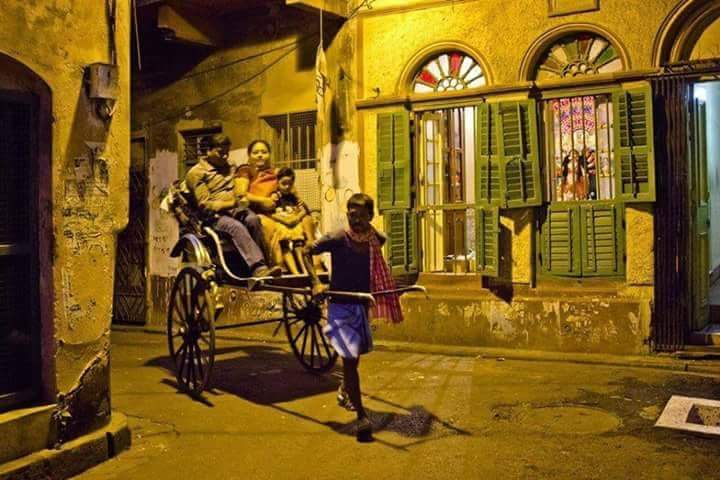Which was the biggest blockbuster coming out of
Tollygunge in 2015?
No prizes for guessing. It’s Belasheshe. It generated an
unprecedented buzz and ran well for months. Such was its resonance from the Bengal box office that Eros – a big production
and international distribution house in Mumbai picked it up and released
nationally. The biggest of production houses in Kolkata acknowledged its exceptional success and its amazing ability to attract the non-Bengali audience.
Now, which was the second biggest success in 2015?
The position was shared by Rajkahini and Shudhu
Tomari Jonyo where the latter was an out-and-out potboiler and the only big success
to boast of among so-called mainstream releases.
Cut to 2016. The same questions come back.
The numero uno was Praktan. This time it was
nationally distributed in 40 centres right at the time of release in May by
Eros. A smart move that paid off big time. It
collected Rs 6.5 crores in the box office till the first seven days of October1.
The second biggest was Zulfiqar. Its collection crossed
Rs 3 crores in 9 days flat1.
None of the movies named above (except Shudhu
Tomari Jonyo) fits in with the perception of conventional Bengali mainstream
cinema. However they struck a chord with a wider audience than so
called alternative or urban cinema and they were lapped up by the audience week
after week.
Is there a trend that has started showing?
There is. In two years on the trot a new kind of
mainstream cinema overshadowed the conventional mainstream flicks that fuel the
stardom of the names like Dev, Jeet and Ankush. Remakes of south Indian movies
– a staple diet of Bengali mainstream cinema– are clearly losing the plot and a major success is becoming more and more elusive with
passing time. None of Jeet’s movies clicked big time at least in Bengal in 2015 and 2016 (Badshah, for which he had made news
with his Rs 1 crore fee reportedly did well in Bangladesh but not Bengal
The neo-mainstream cinema with good content is connecting with audiences far and wide, beyond familiar urban territories (commonly
referred to in the trade as ‘Howrar opare’) and made with reasonable budgets they
are leading to producers smiling all the way to the bank. They are being loved by the urban and suburban viewers, classes and masses alike.The credit for this
feat goes to the respective filmmakers -Shiboprosad-Nandita of Belasheshe
and Praktan and Srijit Mukherji for
Rajkahini and Zulfiqar.
This genre has started adding glimmer to the
pathetic state of popular Bengali cinema thanks to the dominance of poor south
Indian remakes for a painfully long time. Evidently the films by Shiboprosad-Nandita and Srijit brought
back a large section of people to the theatres in Kolkata and districts (for instance, places
like Baruipur and Seoraphuli) who had lost the habit of watching movies in theatres.
In terms of dimension of release too they are showing
signs to be a potential game-changer. Leveraging the impact of Belasheshe,
the
makers of Praktan released it in 101 theatres in Bengal - unprecedented for this kind of cinema .
Such was the excitement in the trade with its release that even a shut down
theatre in Agarpara (north suburbs of Kolkata) re-opened with a hope of a good
time screening the movie. When Zulfiqar was releasing, Srijit rued
the number of theatres it was allocated vis-a-vis Gangster from the same production
house. Zulfiqar got 75 theatres while Gangster got 125. When the box office results came in, Zulfiqar left the latter much
behind validating the director’s wish of a longer theatre list.
If this trend of neo-mainstream cinema gets bigger in the next few years, there will be a paradigm shift in the mainstream cinema market driven by better content. It will be good for the audience as they will have a bigger and better choice of movies.
Half a dozen films are scheduled to release this year which can be categorized in this genre, made by directors like Shiboprosad-Nandita, Kaushik Ganguly, Srijit and Anik Dutta (of Bhooter Bhobishyot fame). Looking forward to see if they are able to fan the trend and make it bigger and stronger.
Half a dozen films are scheduled to release this year which can be categorized in this genre, made by directors like Shiboprosad-Nandita, Kaushik Ganguly, Srijit and Anik Dutta (of Bhooter Bhobishyot fame). Looking forward to see if they are able to fan the trend and make it bigger and stronger.
The role the audience can play in this scenario is spreading the word about the movies
before and after release in their own circles including social media. Audience contribution in raising awareness can be critical in the success of this kind of cinema. There are
cinema groups and pages dedicated to Bangla cinema on Facebook where they can participate. We the Audience is
one such group. This will surely help this trend
bloom into a major change.
Reference
1. Ei Samay, 9th October 2016
#TollyDiaries #BanglaCinema
If you liked reading the post, you may
visit this blog's Facebook
page (click on the link) and hit the 'Like' button to
stay connected with the future updates on this blog and more on the page.









